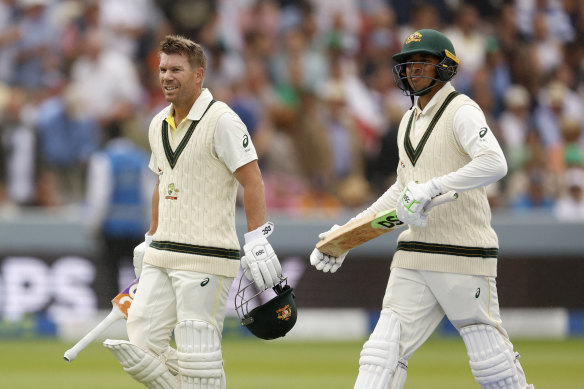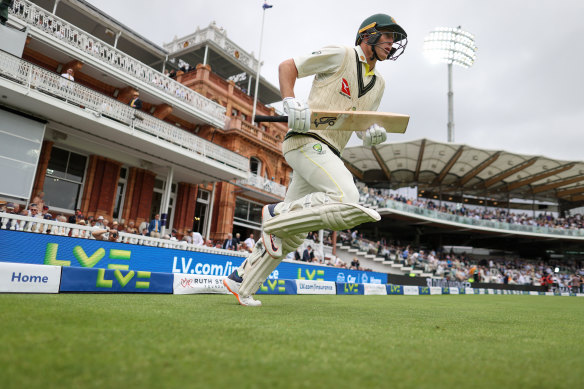Australia’s ‘engine room’ sets platform for Smith and Head exhibition
Save articles for later
Add articles to your saved list and come back to them any time.
London: Matthew Hayden and his contemporaries liked to call Australia’s Test match top three the “engine room”.
Ricky Ponting, Justin Langer and Hayden were the self-appointed drivers of an innings, absorbing the shock of the new ball and making the hard runs against fresh bowlers.
David Warner and Usman Khawaja walk off the field as rain delayed play on day one of the second Test at Lord’s.Credit: Reuters
They were then followed by the “interior decorators” in the middle order who could capitalise on the early ground gained by the top three.
Day one of the Lord’s Test was going to be a significant challenge for any batting engine room, no matter how accomplished.
The lights were on all day, the Dukes ball moved in the air and off the seam throughout, and there was enough carry for edges into the slips cordon. Add to this the vagaries of the Lord’s slope, aiding some balls to move treacherously into or away from the bat, and it was quite the assignment.
Ben Stokes and Brendon McCullum had hoped for such a day to get England back into the Ashes. They asked for a more sporting surface, dropped Moeen Ali for the bouncy seam of Josh Tongue, and Stokes had no hesitation bowling first.
Marnus Labuschagne walks out to bat on day one at Lord’s.Credit: Getty Images
Australia’s older players, too, had memories of days when they found themselves quickly knocked out of a Test match after batting first.
David Warner, Steve Smith, Josh Hazlewood, Mitchell Starc, Nathan Lyon and Pat Cummins were part of the touring squad rolled by James Anderson, Stuart Broad and company on grassy surfaces in Birmingham and Nottingham in 2015.
That team played a Gung Ho style of cricket not a million miles from Bazball – the hard forward presses of numerous members of the top six made them vulnerable to the moving ball.
Eight years later, the Australian top three brought a combination of soft hands and steely focus. They built a priceless platform against an England side that, denied early wickets, looked sloppy and somewhat desultory despite a week’s break since the first Test.
Warner’s innings, interrupted briefly by the Just Stop Oil protestors who invaded the ground after the first over, was his finest in England since that 2015 series.
He was decisive in footwork, proactive in seeking scoring opportunities, and sharp in choosing when and who to attack. Warner’s swept boundary off Ollie Robinson was an early marker. It underlined both the opener’s intent and also that Robinson’s pace is significantly less threatening than he is used to.
Tongue, who bowled several of the best deliveries of the day, was taken for 10 from his first over and conceded close to five an over throughout. Warner made the two-Test seam bowler aware he would be penalised for any errors.
Khawaja played with the sedate air someone who knew the value of getting through the first hour or two for the sake of his teammates. When he misjudged Tongue’s nip backer in the final over before lunch, Khawaja was understandably annoyed, but a tally of 1-73 was golden for Australia.
Marnus Labuschagne, twice tempted into edging Broad’s away swing at Edgbaston, had assiduously re-grooved his plans in the Lord’s nets. He was helped here by the fact that Stokes gave him 29 balls before Broad returned to the England attack, a precious chance to get his bearings.
Steve Smith drives down the ground. Credit: Getty
When their battle rejoined, Labuschagne was beaten by Broad’s first ball, but only because he was covering his stumps. Three boundaries flowed in the next four balls, and Broad became increasingly frustrated as a pair of lbw appeals were denied with the help of technology. Robinson’s fine away nipper to get Labuschagne did not diminish his contribution to the innings’ foundation.
After Warner, deceived by a beauty from Tongue, and Labuschagne fell, Steve Smith and Travis Head took up their interior decorating with an eagerness that made England look still more hangdog – at times fielding as many as three substitutes.
Smith’s innings was almost painterly in its careful consideration of circumstances and opportunities. He charged to 24 from his first 15 balls, seeking to spread the field enough for strike rotation, and then played calmly within his bubble as the afternoon unfolded, as though working to a tradesman’s schedule.
Head, the batter Stokes had pointed out as Australia’s most dangerous before the series, was more brutal, playing as though his interior decoration was being done against the clock on an episode of The Block.
Travis Head bats on day one at Lord’s.Credit: AP
Robinson gave Head a couple of charitable deliveries, obligingly short and wide for the left-hander to free his arms, and soon others followed on the pads. By the time Stokes threw the ball to Joe Root for his nifty off spin and a stumping, Head had already motored to 77, and his stand with Smith was worth 118 in 20 overs.
Cameron Green’s uncharacteristically frantic miscue of a Root short ball to mid off took some of the glimmer from Australia’s day; a stumps score of 3-350 would truly have been a masterwork in the conditions, whereas 5-339 was still open-ended.
The lights had stayed on, the ball continued to move and carry, and the clouds stayed stubbornly overhead. But because the engine room had done its job – in much the same fashion as day one of the World Test Championship final against India – Australia’s interior decorators were in prime position to dominate.
Watch every ball of the 2023 Ashes series live and exclusive on Channel 9 and 9Now.
Sports news, results and expert commentary. Sign up for our Sport newsletter.
Most Viewed in Sport
From our partners
Source: Read Full Article




